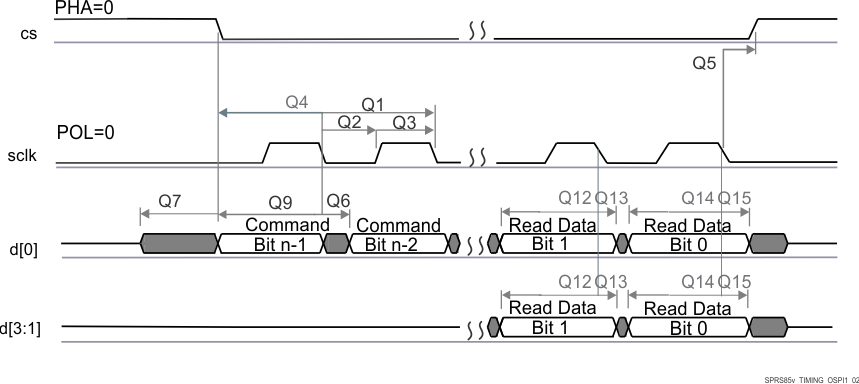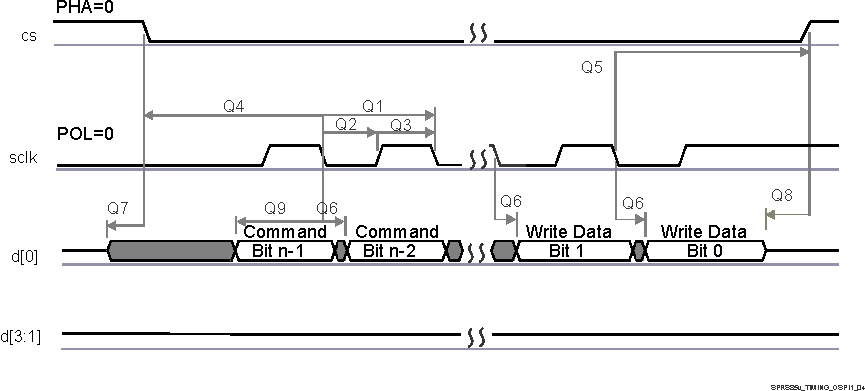JAJSLO2C March 2021 – January 2024 AWR1843AOP
PRODUCTION DATA
- 1
- 1 特長
- 2 アプリケーション
- 3 概要
- 4 Device Comparison
- 5 Terminal Configuration and Functions
-
6 Specifications
- 6.1 Absolute Maximum Ratings
- 6.2 ESD Ratings
- 6.3 Power-On Hours (POH)
- 6.4 Recommended Operating Conditions
- 6.5 Power Supply Specifications
- 6.6 Power Consumption Summary
- 6.7 RF Specification
- 6.8 CPU Specifications
- 6.9 Thermal Resistance Characteristics for FCBGA Package [ALP0180A]
- 6.10
Timing and Switching Characteristics
- 6.10.1 Antenna Radiation Patterns
- 6.10.2 Antenna Positions
- 6.10.3 Power Supply Sequencing and Reset Timing
- 6.10.4 Input Clocks and Oscillators
- 6.10.5 Multibuffered / Standard Serial Peripheral Interface (MibSPI)
- 6.10.6 LVDS Interface Configuration
- 6.10.7 General-Purpose Input/Output
- 6.10.8 Controller Area Network Interface (DCAN)
- 6.10.9 Controller Area Network - Flexible Data-rate (CAN-FD)
- 6.10.10 Serial Communication Interface (SCI)
- 6.10.11 Inter-Integrated Circuit Interface (I2C)
- 6.10.12 Quad Serial Peripheral Interface (QSPI)
- 6.10.13 ETM Trace Interface
- 6.10.14 Data Modification Module (DMM)
- 6.10.15 JTAG Interface
- 7 Detailed Description
- 8 Monitoring and Diagnostics
- 9 Applications, Implementation, and Layout
- 10Device and Documentation Support
- 11Revision History
- 12Mechanical, Packaging, and Orderable Information
パッケージ・オプション
デバイスごとのパッケージ図は、PDF版データシートをご参照ください。
メカニカル・データ(パッケージ|ピン)
- ALP|180
サーマルパッド・メカニカル・データ
発注情報
6.10.12.3 QSPI Switching Characteristics
| NO. | PARAMETER(1)(2)(3) | MIN | TYP | MAX | UNIT | |
|---|---|---|---|---|---|---|
| Q1 | tc(SCLK) | Cycle time, sclk | 25 | ns | ||
| Q2 | tw(SCLKL) | Pulse duration, sclk low | 0.5*P – 3 | ns | ||
| Q3 | tw(SCLKH) | Pulse duration, sclk high | 0.5*P – 3 | ns | ||
| Q4 | td(CS-SCLK) | Delay time, sclk falling edge to cs active edge | –M*P – 1 | –M*P + 2.5 | ns | |
| Q5 | td(SCLK-CS) | Delay time, sclk falling edge to cs inactive edge | N*P – 1 | N*P + 2.5 | ns | |
| Q6 | td(SCLK-D1) | Delay time, sclk falling edge to d[0] transition | –3.5 | 7 | ns | |
| Q7 | tena(CS-D1LZ) | Enable time, cs active edge to d[0] driven (lo-z) | –P – 4 | –P +1 | ns | |
| Q8 | tdis(CS-D1Z) | Disable time, cs active edge to d[0] tri-stated (hi-z) | –P – 4 | –P +1 | ns | |
| Q9 | td(SCLK-D1) | Delay time, sclk first falling edge to first d[1] transition (for PHA = 0 only) | –3.5 – P | 7 – P | ns | |
(1) The Y parameter is defined as follows: If DCLK_DIV is 0 or ODD then, Y equals 0.5. If DCLK_DIV is EVEN then, Y equals (DCLK_DIV/2) / (DCLK_DIV+1). For best performance, it is recommended to use a DCLK_DIV of 0 or ODD to minimize the duty cycle distortion. The HSDIVIDER on CLKOUTX2_H13 output of DPLL_PER can be used to achieve the desired clock divider ratio. All required details about clock division factor DCLK_DIV can be found in the device-specific Technical Reference Manual.
(2) P = SCLK period in ns.
(3) M = QSPI_SPI_DC_REG.DDx + 1, N = 2
 Figure 6-18 QSPI Read (Clock Mode 0)
Figure 6-18 QSPI Read (Clock Mode 0) Figure 6-19 QSPI Write (Clock Mode 0)
Figure 6-19 QSPI Write (Clock Mode 0)